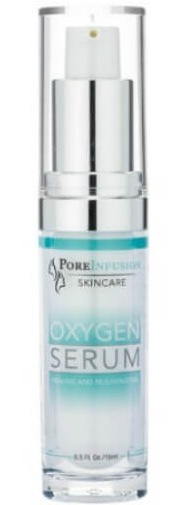
Oxygen Serum
Highlights
Skim through
| Ingredient name | what-it-does | irr., com. | ID-Rating |
|---|---|---|---|
| Purified Water (Aqua) | solvent | ||
| Perfluorodecalin | solvent | ||
| Polyperfluoromethylisopropyl Ether | |||
| Isoceteth-20 | emulsifying, surfactant/cleansing | ||
| Phenoxyethanol | preservative | ||
| Ethylhexylglycerin | preservative |
Pore Infusion Oxygen SerumIngredients explained
Good old water, aka H2O. The most common skincare ingredient of all. You can usually find it right in the very first spot of the ingredient list, meaning it’s the biggest thing out of all the stuff that makes up the product.
It’s mainly a solvent for ingredients that do not like to dissolve in oils but rather in water.
Once inside the skin, it hydrates, but not from the outside - putting pure water on the skin (hello long baths!) is drying.
One more thing: the water used in cosmetics is purified and deionized (it means that almost all of the mineral ions inside it is removed). Like this, the products can stay more stable over time.
Perfluorodecalin is a fluorocarbon, a molecule that contains nothing else but carbon and fluorine. It's usually mixed with other fluorocarbons and goes by the trade name Fiflow. Fiflows are interesting materials: they are very stable (inert), heavy liquids that are neither water nor oil soluble but they create a third phase in emulsions. They can carry gasses, notably Oxygen, Nitrogen and Carbon Dioxide into the formula.
The manufacturer claims that Fiflow blends can have all kinds of good effects on the skin: they can have wound healing, muscle relaxation, and dermal filling effect and they might also improve skin renewal and skin elasticity.

A handy helper ingredient that works as an emulsifier or solubilizer to include oil-loving ingredients (such as fragrance) into water-based products.
It’s pretty much the current IT-preservative. It’s safe and gentle, but even more importantly, it’s not a feared-by-everyone-mostly-without-scientific-reason paraben.
It’s not something new: it was introduced around 1950 and today it can be used up to 1% worldwide. It can be found in nature - in green tea - but the version used in cosmetics is synthetic.
Other than having a good safety profile and being quite gentle to the skin it has some other advantages too. It can be used in many types of formulations as it has great thermal stability (can be heated up to 85°C) and works on a wide range of pH levels (ph 3-10).
It’s often used together with ethylhexylglycerin as it nicely improves the preservative activity of phenoxyethanol.
If you have spotted ethylhexylglycerin on the ingredient list, most probably you will see there also the current IT-preservative, phenoxyethanol. They are good friends because ethylhexylglycerin can boost the effectiveness of phenoxyethanol (and other preservatives) and as an added bonus it feels nice on the skin too.
Also, it's an effective deodorant and a medium spreading emollient.
You may also want to take a look at...
| what‑it‑does | solvent |
| what‑it‑does | solvent |
| what‑it‑does | emulsifying | surfactant/cleansing |
| what‑it‑does | preservative |
| what‑it‑does | preservative |





